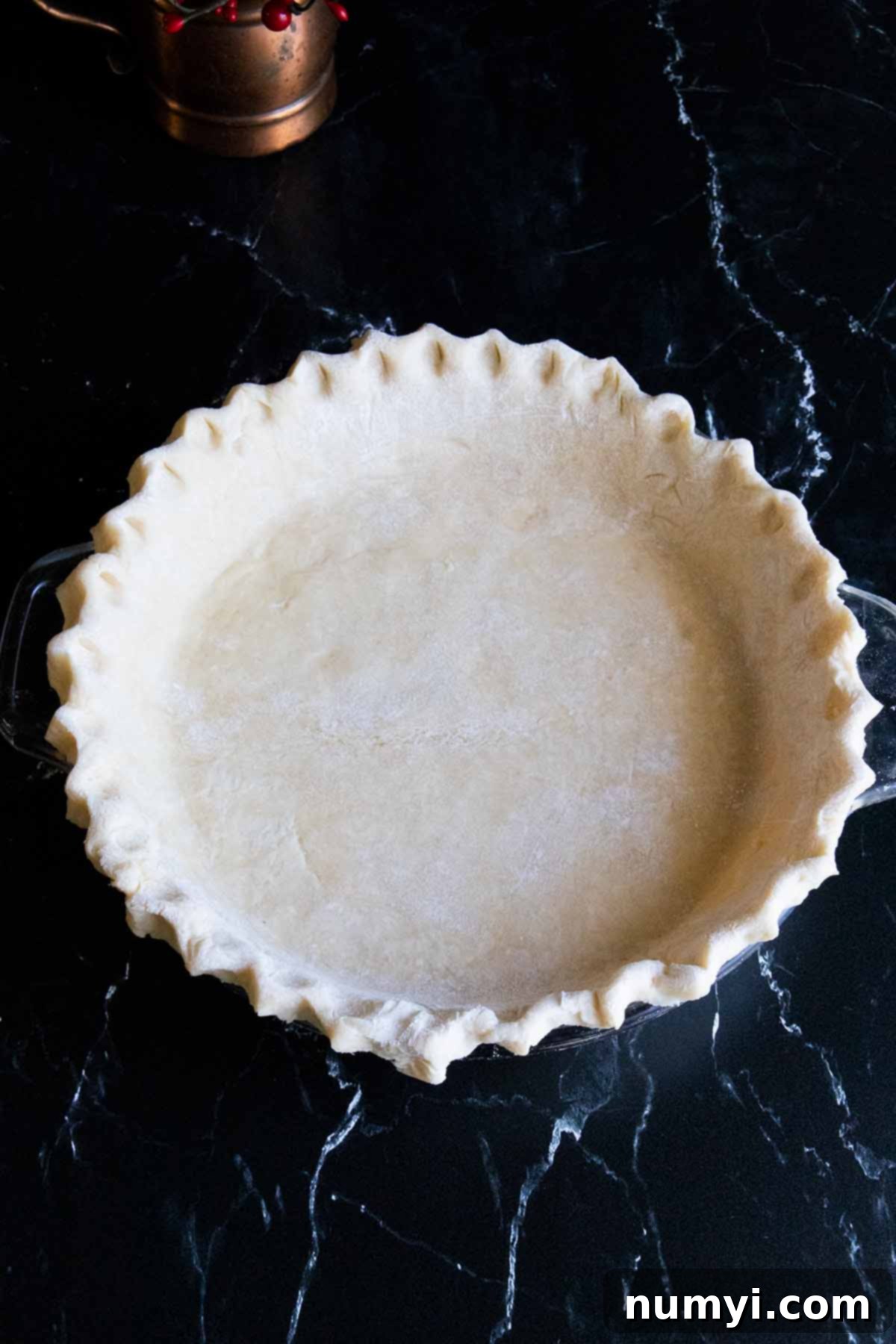Mastering the Flaky Difference: Your Guide to Easy All-Butter Pie Crust from Scratch
There’s an undeniable joy and satisfaction that comes from baking a homemade pie. But the true foundation of any exceptional pie lies in its crust. This Easy All-Butter Pie Crust Recipe is your ultimate guide to achieving a consistently buttery, impossibly flaky, and utterly delicious pie crust every single time. Say goodbye to bland, crumbly, or tough store-bought alternatives and embrace the superior taste and texture of a crust made from scratch. This comprehensive guide will demystify the process, making homemade pie crust accessible for even novice bakers.

Don’t Sweat The Recipe is supported by its readers. We may earn a commission if you purchase through a link on our site. Learn more.
Why You’ll Love This Homemade Pie Crust
Creating a perfect pie crust from scratch is incredibly rewarding, transforming a simple dessert into a culinary masterpiece. This recipe simplifies the process, ensuring you’ll never feel intimidated by homemade pie dough again. Here’s why this will become your go-to recipe:
- Unmatched Flavor and Texture: You’ll achieve a pie crust that is tender, rich with buttery flavor, incredibly flaky, and wonderfully crispy with every bite. The depth of flavor from real butter simply cannot be replicated by store-bought crusts.
- Effortless Preparation: Despite its gourmet results, this recipe is surprisingly easy and quick to prepare, especially with the help of a food processor. You’ll be amazed at how quickly you can bring together such a high-quality dough.
- Versatile for Any Pie: This robust and flavorful crust is perfect for a wide array of pies, both sweet and savory. Imagine it cradling the rich filling of an Apple Pie, the creamy texture of a Southern Sweet Potato Pie, the fruity burst of a Blueberry Slab Pie, the seasonal delight of Pumpkin Pie, or the freshness of a Fresh Strawberry Pie. It’s equally fantastic for savory creations, like a hearty Leftover Thanksgiving Pie recipe.
- Proudly Homemade: There’s immense satisfaction in presenting a dessert where every component, right down to the crust, is made with your own hands. Your guests will notice the difference!
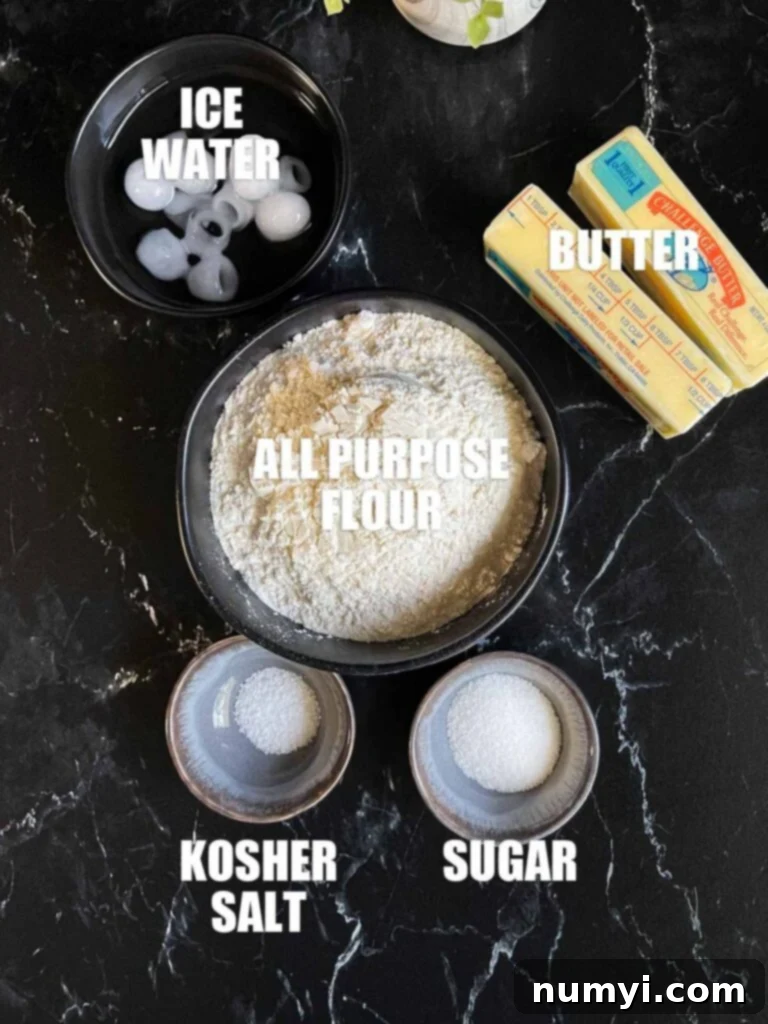
Key Ingredients for a Flaky Butter Pie Crust
The secret to a truly spectacular pie crust lies in understanding the role of each high-quality ingredient. Here’s what you’ll need and why:
- All-Purpose Flour: This is the backbone of your crust. Opt for a good quality all-purpose flour, as its relatively low protein content helps to achieve a tender, rather than tough, and flaky texture. Too much gluten development from high-protein flour or overmixing can lead to a chewy crust, which is not what we want for pie.
- Unsalted Butter: The star of an “all-butter” crust! Unsalted butter allows you to control the total sodium content, and its rich fat content is crucial for flavor and flakiness. The key is to use *cold* butter. As the cold butter melts in the hot oven, its water content turns into steam, which lifts the layers of dough, creating those coveted airy, flaky pockets. Cubing the butter and keeping it cold ensures it disperses evenly throughout the flour without fully incorporating, preserving distinct fat pockets.
- Kosher Salt and Granulated Sugar: These two pantry staples aren’t just for flavor. Salt balances the richness of the butter and enhances all the other flavors in your pie. A small amount of granulated sugar contributes to a subtle sweetness in the crust and aids in browning, giving your pie a beautiful golden hue. They both play a role in the overall deliciousness of your baked goods.
- Ice Water: Just like the butter, cold water is paramount. It helps to keep the butter solid, preventing it from melting prematurely and forming a greasy dough. Cold water also inhibits excessive gluten development, ensuring your crust remains tender and flaky. It moistens the flour just enough to bind the dough without overworking it. Always have extra ice water on hand, but add it judiciously, a tablespoon at a time.
How to Make Homemade All-Butter Pie Crust Dough
Making pie crust is a straightforward process, especially with the right tools and techniques. Here’s a step-by-step guide:
Using a Food Processor (Recommended for Speed and Ease)
- Combine Dry Ingredients: In the bowl of a food processor, combine the all-purpose flour, granulated sugar, and kosher salt. Pulse a few times, about 5-10 short bursts, to ensure they are well mixed. This initial step prevents pockets of unmixed salt or sugar.
- Incorporate Cold Butter: Add the cold, cubed unsalted butter to the flour mixture. Pulse the food processor in short bursts (about 1-second pulses) until the mixture resembles coarse crumbs, with some pea-sized butter pieces still visible. It’s crucial not to over-process at this stage; visible butter chunks are key to flakiness.
- Add Ice Water Gradually: With the food processor running, gradually add the ice-cold water, one tablespoon at a time, through the feed tube. Process only until the dough just begins to come together. You may need 5 to 6 tablespoons, or sometimes a little more or less depending on humidity and flour. Stop immediately once the dough starts to clump together.
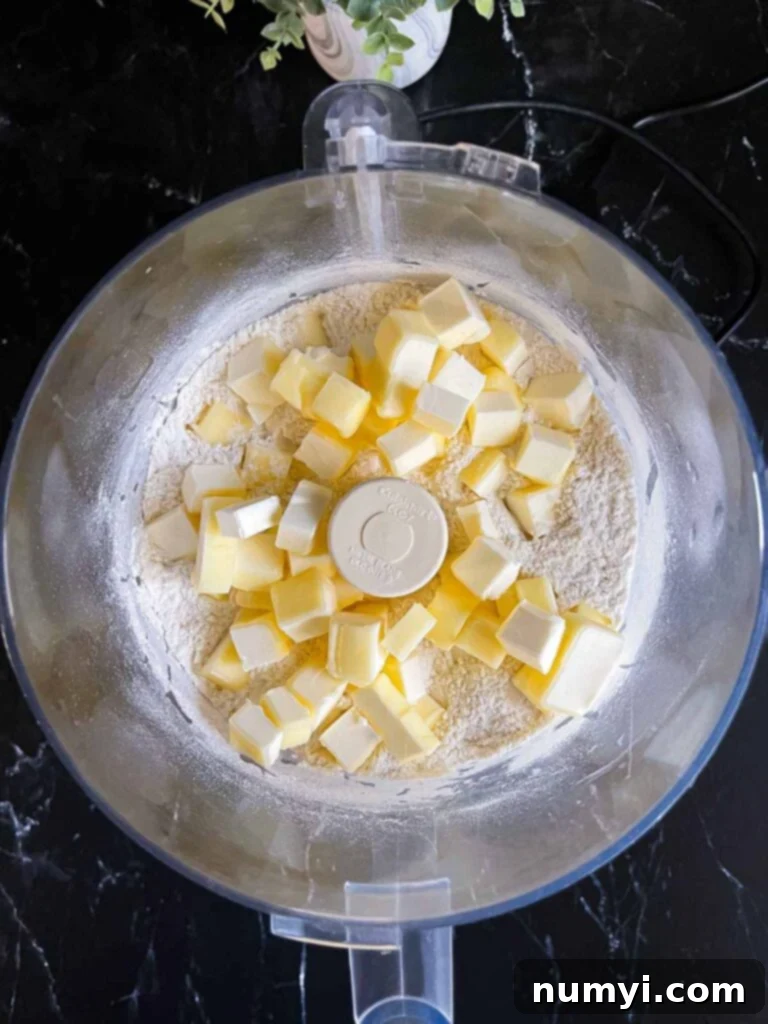
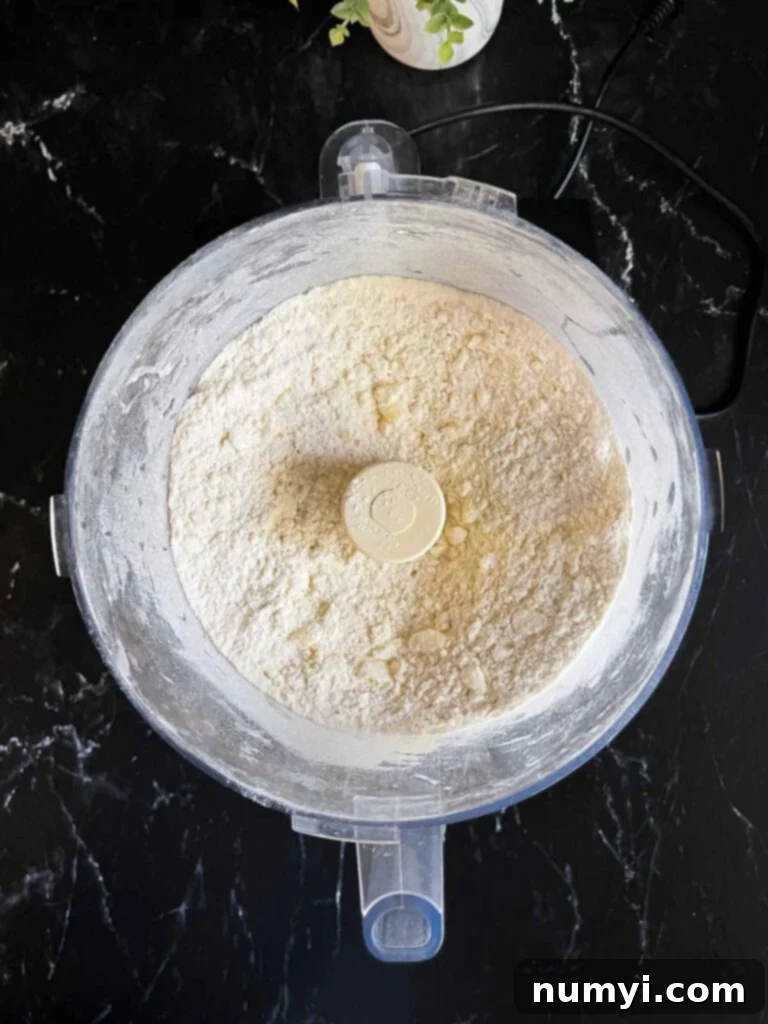
Important Note: DO NOT overwork the dough in the processor. Overworking develops the gluten too much, which will result in a tough, hard pie crust instead of the desired tender, flaky texture.
Manual Method (No Food Processor Needed)
If you don’t have a food processor, don’t worry! You can achieve excellent results with a pastry cutter or even your fingertips. In a large bowl, combine flour, sugar, and salt. Add the cold, cubed butter. Use the pastry cutter to cut the butter into the flour until it forms a coarse meal with pea-sized pieces of butter. Then, gradually add ice water, stirring with a fork or your hands until the dough just comes together. This method requires a bit more arm work but is equally effective in producing a flaky dough.

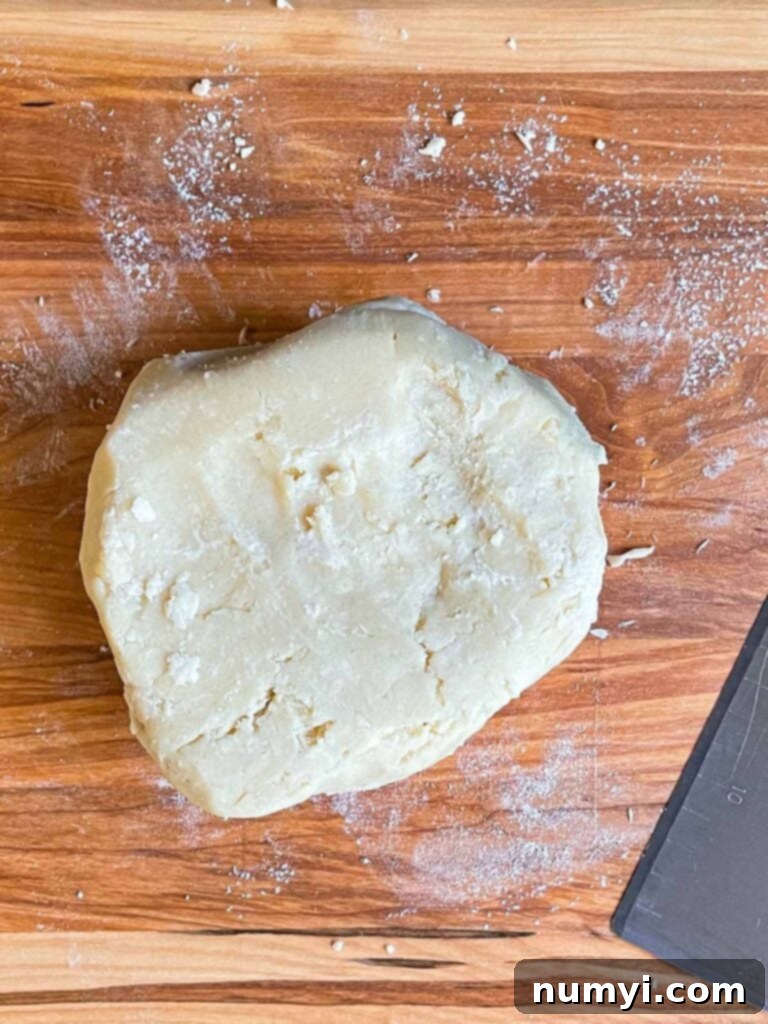
Forming and Chilling the Dough
- Lightly Knead: Dump the dough onto a lightly floured surface. Gently knead it a few times, just enough to bring it completely together into a cohesive mass. Avoid excessive kneading; we want to minimize gluten development.
- Divide and Shape: Divide the dough in half. This recipe yields approximately 21 ounces of dough, so each half should weigh about 10.5 ounces for a balanced double-crust pie. Shape each piece into a round ball, then gently flatten each ball into a disk. The disk shape makes it easier to roll out later.
- Chill Thoroughly: Wrap each disk tightly in plastic wrap to prevent it from drying out. Refrigerate for at least one hour, or ideally for 2-3 hours, and up to 3 days. This chilling period is crucial: it allows the gluten to relax, which prevents the crust from shrinking during baking, and it firms up the butter, which is essential for flakiness.
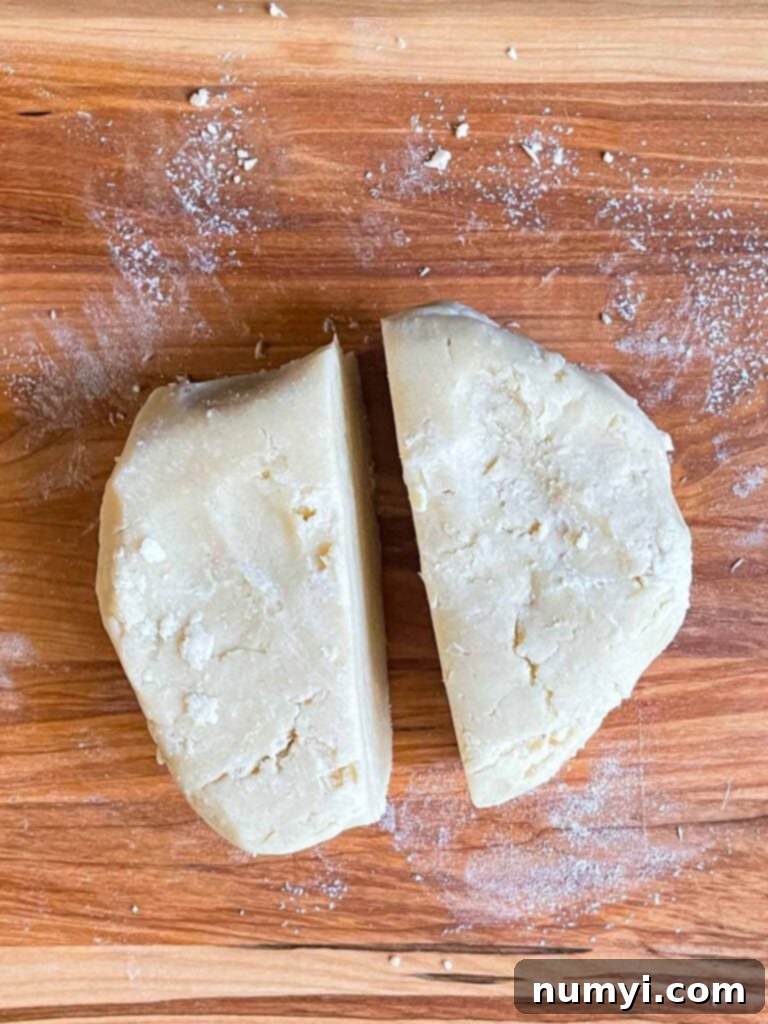
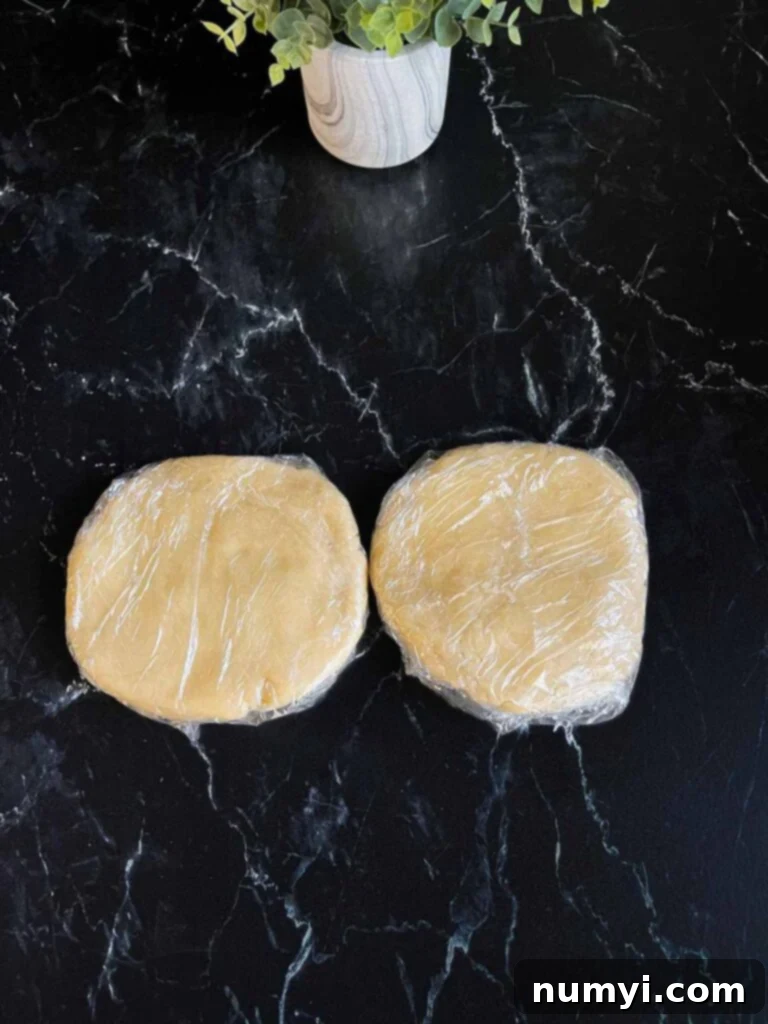
How to Roll Out Pie Dough Like a Pro
Rolling out pie dough can seem daunting, but with a few simple tricks, you’ll be a master in no time.
- Prepare Your Workspace and Dough: Have a 9-inch pie plate ready. Remove one disk of dough from the refrigerator, leaving the other chilled. Let the dough sit at room temperature for 10-15 minutes before rolling. This slightly softens the butter, preventing the cold dough from cracking excessively, while still keeping it cool enough to handle.
- Flour Your Surface: Lightly flour your work surface and rolling pin. Avoid using too much flour, as it can make the crust tough. A little dusting is all you need.
- Roll with Even Pressure: Using a rolling pin, start rolling out the dough disk from the center outwards, applying medium, even pressure. Rotate the dough frequently (after every few rolls) to maintain a circular shape and prevent it from sticking to the surface. Flip the dough occasionally as well, lightly re-flouring if needed.
- Achieve the Right Size and Thickness: Continue rolling and turning until you have a uniform 12-inch circle, approximately 1/8 to 1/4 inch thick. A 12-inch circle is ideal for a standard 9-inch pie pan, providing enough overhang for crimping.
- Transferring the Dough: This step requires a gentle touch. Carefully lift one edge of the dough and drape it over your rolling pin. Lift the rolling pin with the dough over your pie plate and gently ease the dough down into the pan. This technique minimizes stretching and tearing. The dough will be thin, so handle it slowly and with care. If it tears, simply patch it with a small piece of excess dough, pressing gently to seal.
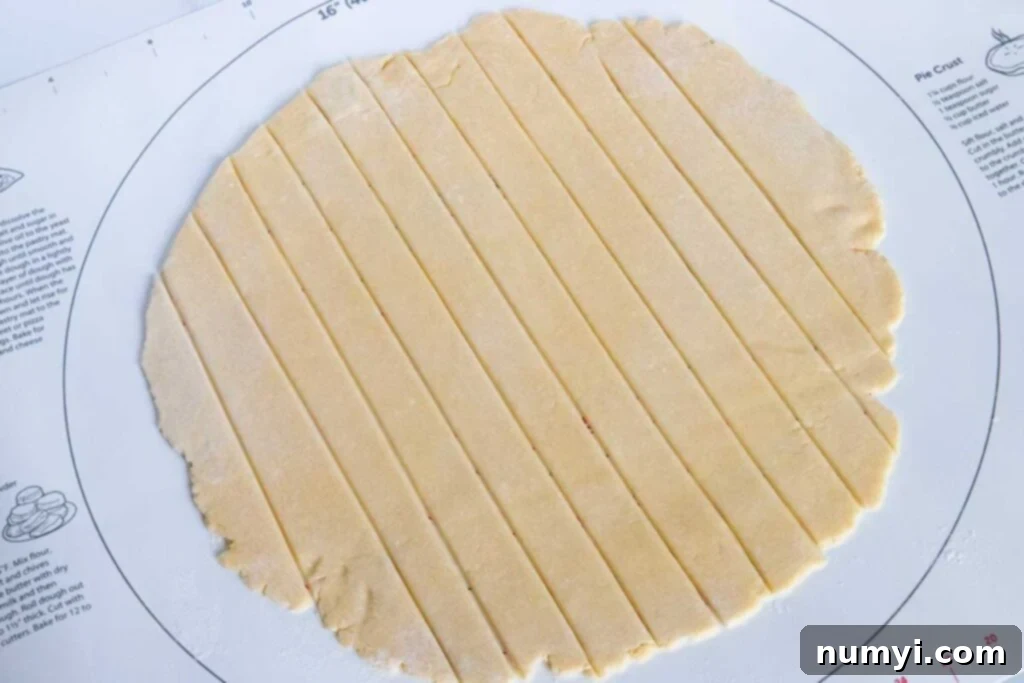
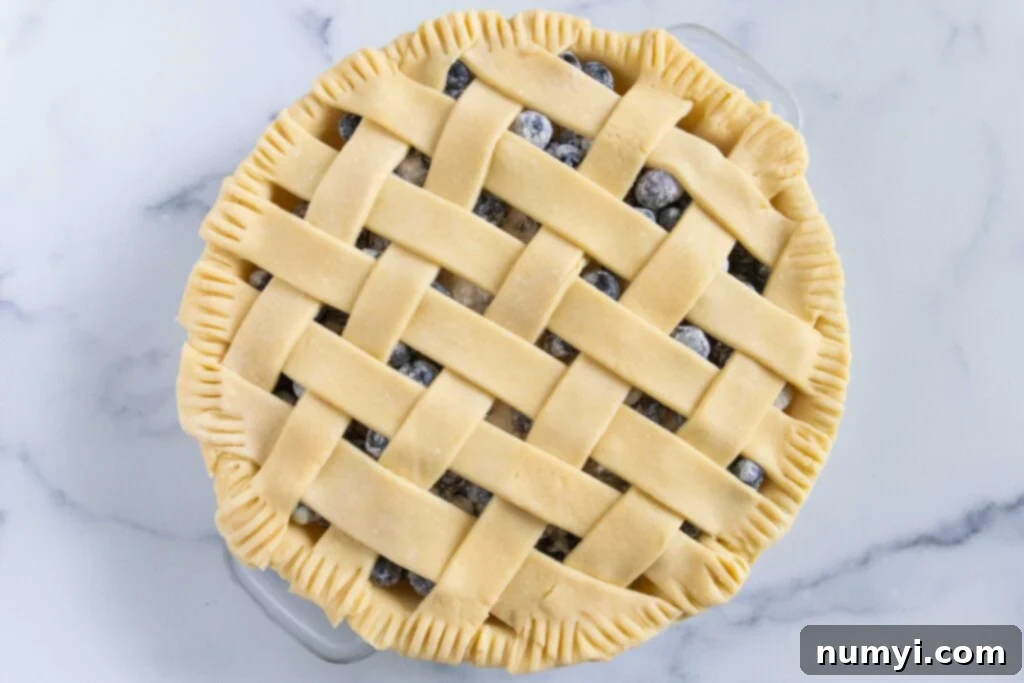
Finishing Touches for Your Pie Crust
- Trim and Fill: Trim any excess dough around the edges, leaving about a 1-inch overhang. This extra dough is essential for forming a beautiful edge. At this point, you can add your pie filling.
- Add Top Crust (Optional) and Seal: If making a double-crust pie, roll out the second disk of dough. You can either place it as a solid top crust or cut it into 3/4 to 1-inch strips for an elegant lattice top crust. Once the top crust is in place, fold the 1-inch overhang from the bottom crust back over the top crust, then gently pinch the top and bottom crusts together to seal.
- Crimp or Flute the Edges: Now, create that signature decorative edge.
- To Flute: Use the index finger and thumb of one hand to gently press the dough, while simultaneously using the index finger of your other hand to push the dough in between the first two fingers, creating a scalloped, wavy design around the entire edge.
- To Crimp: For a simpler, rustic look, press the tines of a fork around the entire edge of the pie.
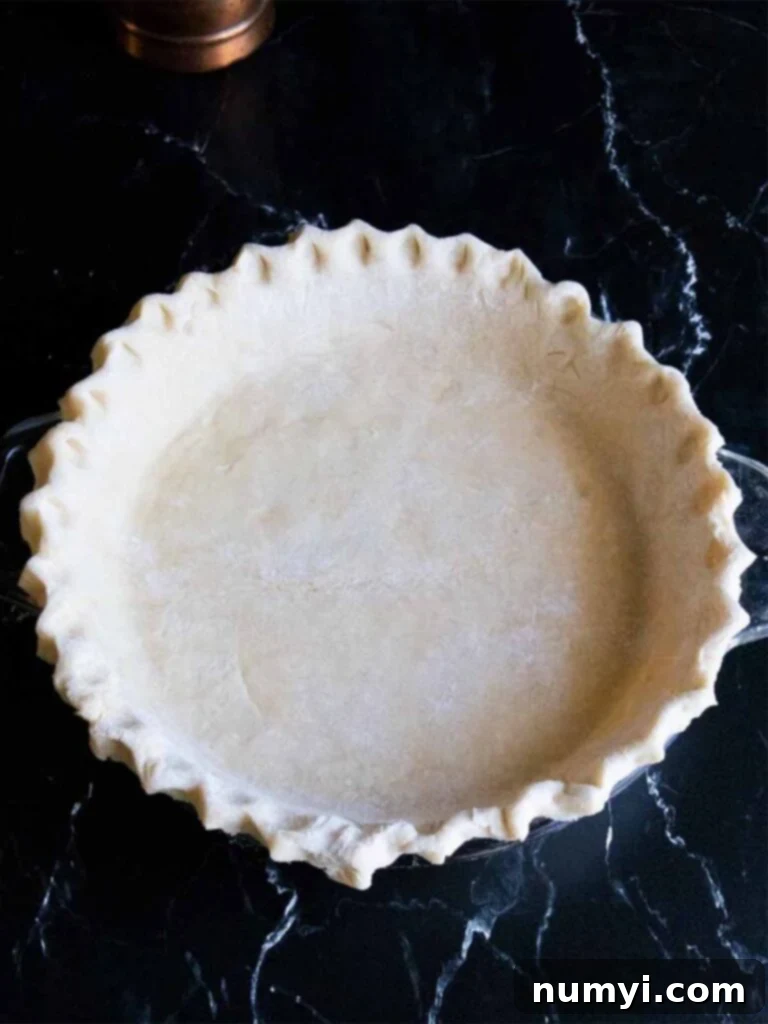
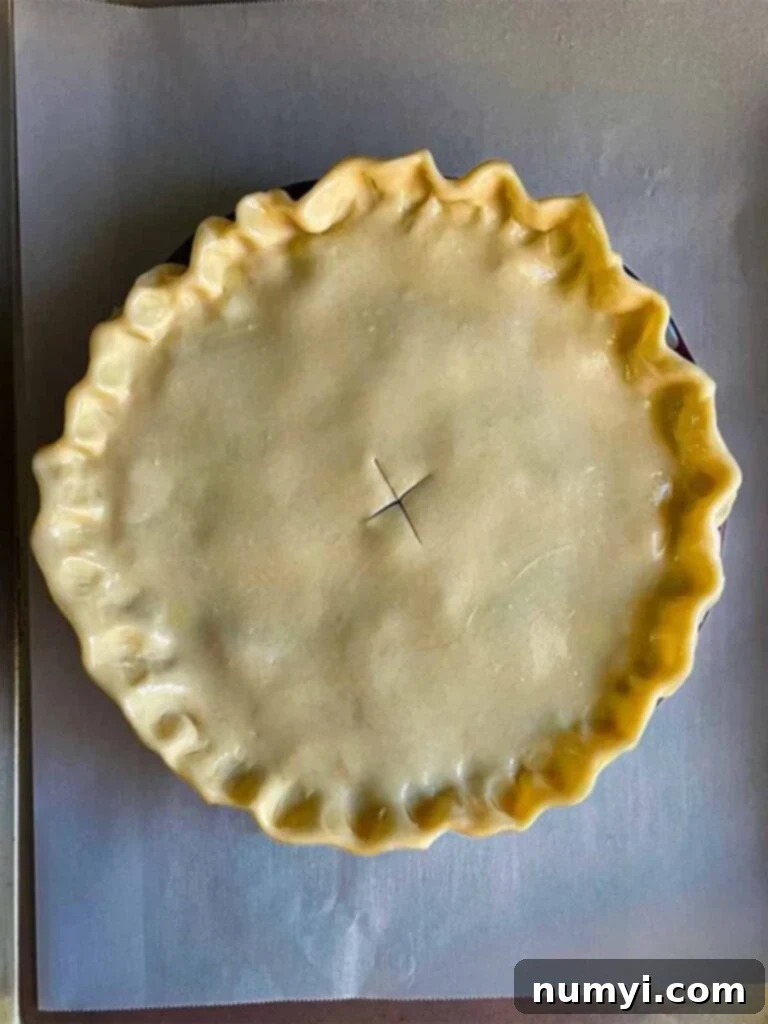
Preventing a Soggy Bottom: To help prevent the bottom crust from becoming soggy from the filling, I like to brush the bottom crust with a thin layer of egg wash (one egg yolk mixed with a tablespoon of water) and then refrigerate it for about 15-20 minutes while preparing the filling and top crust. This creates a protective barrier.
Pre-Baking Chill: Before baking, I also recommend freezing the formed pie for at least 15 minutes. This ensures the butter is thoroughly cold and firm, which is critical for maximum flakiness when it hits the hot oven. This final chill also helps the crust hold its shape better during baking.
The Secret to a Perfect Flaky Pie Crust: Cold Ingredients
The “secret” to achieving a truly perfect, flaky pie crust isn’t really a secret at all, but rather a fundamental principle of baking: cold ingredients and keeping the pie dough chilled at all times. This concept is so crucial it bears repeating and understanding.
When the butter in your dough is kept cold, it remains in solid, distinct pieces throughout the flour. As the pie bakes in a hot oven, these cold butter pieces melt, releasing their water content. This water rapidly turns into steam. This steam then pushes against the layers of dough, forcing them apart and creating hundreds of tiny, airy pockets. These pockets are what give pie crust its characteristic light, crisp, and incredibly flaky texture.
If the butter is allowed to get too warm and fully incorporate into the flour before baking, it creates a more uniform, cookie-like texture rather than distinct layers. Keeping the dough cold prevents the fat from melting too soon, ensuring that transformative burst of steam occurs at the optimal moment in the oven. So, don’t rush the chilling steps – they are your best friend for a genuinely flaky crust!
Par-Baking (Blind Baking) Your Pie Crust
Some pie recipes, particularly those with very wet fillings or custard bases, call for a par-baked (or blind-baked) crust. This means partially or fully baking the crust before adding the filling to ensure a crisp bottom and to prevent sogginess. Here’s how to do it effectively:
- Prepare the Crust: Roll out your pie dough and fit it into your pie plate as described above, crimping or fluting the edges. Then, place the pie plate with the crust into the freezer for at least 30 minutes. This helps the butter firm up and prevents shrinkage during baking.
- Line and Weigh: Once the crust is well-chilled, line the inside of the dough with parchment paper or aluminum foil, making sure it extends slightly over the edges. Fill the lined crust with pie weights, dried beans, or granulated sugar. Spread the weights evenly to fill every nook and cranny and press gently against the sides. The weights hold the dough in place, preventing it from bubbling up or sliding down the sides.
- Bake: Blind bake the pie crust as instructed in your specific recipe. Typically, this involves baking at a high temperature (around 400°F/200°C) for 15-20 minutes with the weights, then removing the weights and baking for another 5-10 minutes until the crust is golden and dry.
- Re-using Toasted Sugar: If you use granulated sugar as pie weights, don’t discard it! The sugar will toast slightly during baking, developing a delicious, complex flavor. Once cooled, you can use this toasted sugar in other recipes, like for making a caramel sauce, sprinkling on oatmeal, or in cookies, adding a unique depth of flavor.
Expert Tips for a Consistently Successful Pie Crust
Even with a great recipe, a few additional tips can elevate your pie crust game:
- Embrace Cold Ingredients: This is the golden rule! Always use very cold butter and ice water. For extra insurance, you can even chill your flour in the freezer for 15-20 minutes before starting.
- Chill Between Every Step: Don’t underestimate the power of chilling. If your dough becomes too warm or sticky during any stage (mixing, forming disks, rolling), pop it back into the refrigerator or even the freezer for 10-15 minutes to firm up the butter again. This prevents the butter from melting and ensures those distinct fat pockets that create flakiness.
- Add Water Incrementally: The amount of water needed can vary slightly depending on the humidity and your flour. Always add the ice water one tablespoon at a time. Too much water will result in a sticky, unmanageable dough that requires more flour (leading to a tough crust). Too little water will leave you with a dry, crumbly dough that won’t come together or roll out properly. Aim for just enough moisture for the dough to barely hold its shape.
- Avoid Overmixing/Overworking: This is another critical tip. Overmixing or over-kneading develops gluten, making the crust tough and dense. Whether using a food processor or doing it by hand, stop as soon as the dough just comes together. A few crumbs are fine!
- Gentle Kneading for Ball Formation: When bringing the dough together on your lightly floured surface, knead only a few gentle times. If the dough feels too crumbly, dampen your hands with a tiny bit of ice water to add moisture. If it feels too sticky and wet, dust with a small amount of flour and continue forming the ball.
- No Food Processor? No Problem!: As mentioned, a sturdy pastry blender or even two forks work wonderfully for cutting in the butter. You can also use your fingertips, but work quickly to prevent the butter from warming too much.
- Rolling Pin Technique: For even rolling, always start from the center and roll outwards. Rotate the dough a quarter turn frequently, and flip it over occasionally to ensure it’s not sticking to the surface. This creates a uniform thickness and a round shape.
Delicious Variations for Your Pie Crust
While this classic all-butter crust is perfect as is, you can easily customize it to complement different pie fillings:
- Vodka Trick for Extra Flakiness: For an exceptionally flaky crust, substitute some of the ice water (e.g., 2-4 tablespoons) with chilled vodka. Alcohol evaporates more quickly than water and, crucially, it doesn’t promote gluten development. This results in an even more tender and flaky crust without sacrificing moisture.
- Sweeten it Up: If you prefer a sweeter pie crust for dessert pies, increase the amount of granulated sugar by an extra tablespoon or two. You can also add a pinch of cinnamon or nutmeg for warmth.
- Flavor Infusions: Get creative with flavorings!
- Sweet Crusts: Add a teaspoon of vanilla extract, almond extract, or a pinch of ground spices like cinnamon, cardamom, or ginger directly to the dry ingredients. Citrus zest (lemon, orange, or lime) also adds a bright, aromatic note.
- Savory Crusts: For savory pies (like quiches or pot pies), consider adding finely chopped fresh herbs (rosemary, thyme, sage), a teaspoon of garlic powder, onion powder, or a pinch of smoked paprika to the flour mixture. A little grated Parmesan cheese can also add wonderful depth.
- Whole Wheat Inclusion: For a slightly nutty flavor and added fiber, substitute up to half of the all-purpose flour with whole wheat pastry flour. This creates a more rustic crust.
Frequently Asked Questions About Pie Crust
Unbaked pie dough disks can be refrigerated for up to 3 days. Ensure they are wrapped tightly in plastic wrap to prevent them from drying out or absorbing odors from the fridge. Before rolling, let the dough sit at room temperature for 10-15 minutes to prevent cracking.
Absolutely! Pie crusts are excellent for freezing, allowing you to prep ahead. Wrap each dough disk tightly in plastic wrap, then place them into a freezer-safe bag or airtight container. They can be frozen for up to 3 months. When ready to use, thaw the dough in the refrigerator overnight. This recipe yields enough for a double-crust pie; if you only need one crust for a single-crust pie, you can easily freeze the other disk for later use.
Shrinkage often occurs if the gluten in the dough wasn’t sufficiently relaxed before baking. This happens when the dough isn’t chilled long enough or is overworked during mixing/kneading. Ensure adequate chilling time (at least 1 hour, ideally 2-3 hours) to allow the gluten to relax, and avoid overworking the dough.
A soggy bottom crust is usually due to moisture from the filling soaking into an underbaked or unprotected crust. To prevent this, consider par-baking the crust (especially for wet fillings), brush the bottom crust with an egg wash before filling, or add a thin layer of breadcrumbs or crushed cornflakes to absorb excess moisture before adding the filling.
A tough crust is almost always a sign of overworking the dough. Excessive mixing or kneading develops the gluten, making the crust chewy rather than tender. Use cold ingredients, add water sparingly, and handle the dough as little as possible to keep it light and flaky.
Explore More Delicious Pie Recipes
Now that you’ve mastered the perfect pie crust, put your skills to the test with these fantastic pie recipes:
Old-Fashioned Pecan Pie Recipe (without corn syrup)
Homemade Coconut Cream Pie
Blueberry Pie
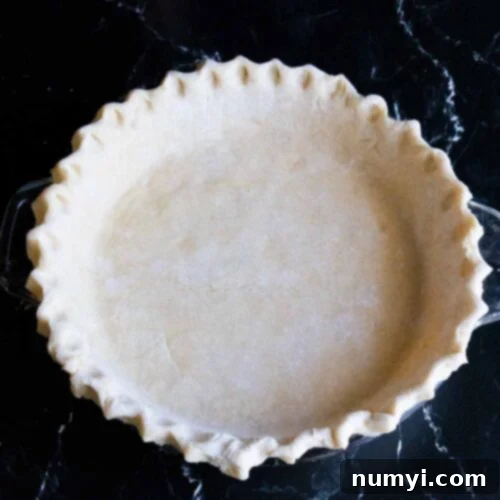
Pie Crust Recipe
Print
Pin
Rate
Ingredients
- 2 1/2 cups All-purpose flour or pastry flour
- 1 cup Unsalted butter cold, cubed
- 1 tbsp Granulated sugar
- 1/2 tsp Kosher salt
- 5-6 tbsp Ice water (or half chilled vodka)
Instructions
-
In the bowl of a food processor, combine the flour, sugar, and salt. Pulse a few times to mix. Add the cold butter pieces and pulse until the mixture looks like coarse crumbs with some pea-sized butter chunks remaining. With the processor running, gradually add ice-cold water one tablespoon at a time and process until the dough just begins to come together into a cohesive mass. Stop immediately once this consistency is reached.2 1/2 cups All-purpose flour,
1 cup Unsalted butter,
1 tbsp Granulated sugar,
1/2 tsp Kosher salt,
5-6 tbsp Ice water -
Dump the dough onto a lightly floured surface and gently knead a few times, just until it comes together into a ball. Do not over-knead.
Divide the dough in half (approximately 10.5 ounces each). Shape each piece into a ball, then flatten each ball into a disk. Wrap each disk tightly in plastic wrap and refrigerate for at least one hour or up to 3 days to chill thoroughly before rolling.
Notes
If you do not have a food processor, you can easily make this pie crust by using a pastry cutter (or two forks, or your fingertips) to cut in the cold butter cubes into the flour mixture, then mixing in the water by hand until just combined.
Storing and Freezing: Wrapped tightly in plastic wrap, the prepared dough disks can be refrigerated for up to 3 days. For longer storage, freeze the tightly wrapped disks in a freezer-safe bag for up to 3 months. Thaw in the refrigerator overnight before use.
Nutrition
Carbohydrates: 31g |
Protein: 4g |
Fat: 23g |
Saturated Fat: 15g |
Polyunsaturated Fat: 1g |
Monounsaturated Fat: 6g |
Trans Fat: 1g |
Cholesterol: 61mg |
Sodium: 150mg |
Potassium: 49mg |
Fiber: 1g |
Sugar: 2g |
Vitamin A: 709IU |
Calcium: 13mg |
Iron: 2mg
